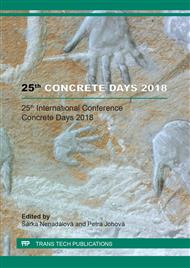p.29
p.34
p.40
p.45
p.50
p.56
p.63
p.69
p.79
Influence of the Poisson’s Ratio on the Value of the Dynamic Modulus of Elasticity of Cement Materials in the Early Stage of Ageing
Abstract:
The paper deals with the influence of the Poisson’s ratio on the calculated modulus of elasticity of a cementitious composite in the early stage of its ageing. The dynamic modulus of elasticity was determined in the first 24 hours of ageing of the material using the Vikasonic ultrasonic device. Within the experiment, two types of cementitious composites were mixed - cement paste and cement mortar, both having the same water/cement ratio. It is presumed that the value of the dynamic modulus of elasticity calculated on the basis of ultrasonic measurement is closely related to the value of the Poisson’s ratio, which is not constant during ageing of the cementitious composite but varies depending on the degree of hydration of the material. The output of the paper is a comparison of the development of the dynamic modulus of elasticity calculated using different values of the Poisson’s ratio.
Info:
Periodical:
Pages:
50-55
Citation:
Online since:
June 2019
Authors:
Price:
Сopyright:
© 2019 Trans Tech Publications Ltd. All Rights Reserved
Share:
Citation:


